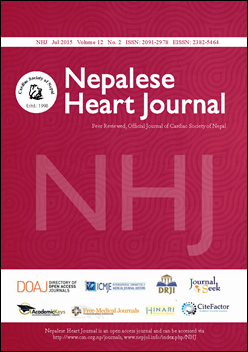Fractional Flow Reserve for Intermediate Coronary Artery Stenosis in Nepal
DOI:
https://doi.org/10.3126/njh.v12i2.13384Keywords:
Fractional flow reserve, Intermediate coronary stenosis, RevascularizationAbstract
Background and Aims: : Coronary angiogram detects anatomical lesion, however, has limited ability to assess physiological significance. Fractional flow reserve is used to determine functional significance of stenosis and is measured by the ratio of mean distal coronary pressure to mean aortic pressure during maximum hyperemia. Recently, fractional flow reserve was started in Nepal. This study intends to explore the extent of determination of hemodynamic significance of intermediate coronary stenosis by fractional flow reserve, thereby guiding revascularization.
Methods: Consecutive patients with intermediate lesion undergoing fractional flow reserve from July 2014 to March 2015 were included, if fractional flow reserve ?0.80 then considered to be significant and need for revascularization determined. The study subjects were divided into two groups, one having physiologically significant stenosis and another with physiologically non significant lesion and followed up to three months.
Results: Total forty four patients had fractional flow reserve done in fifty eight intermediate coronary artery lesions. The age ranged from 33 to 78 with the mean age of 58.25}10.08 years. Majority of them (75%) were male. Left anterior descending artery was commonest in 37(63.8%), followed by left circumflex 13(22.4%), then right coronary artery in 8(13.8%) target lesions. None of the patient had death, myocardial infarction or repeat revascularization during follow up. Out of 58 intermediate lesions assessed, 17(29.31%) had significant fractional flow reserve value, whereas 41(70.69%) had physiologically non significant lesion.
Conclusion: Around one third (29.31%) of intermediate coronary artery stenosis are functionally significant by fractional flow reserve in the context of Nepal, thus it could be useful guide for optimal revascularization.
Nepalese Heart Journal 2015;12(2):69-72
Downloads
Downloads
Published
How to Cite
Issue
Section
License
This license enables reusers to distribute, remix, adapt, and build upon the material in any medium or format, so long as attribution is given to the creator. The license allows for commercial use.




